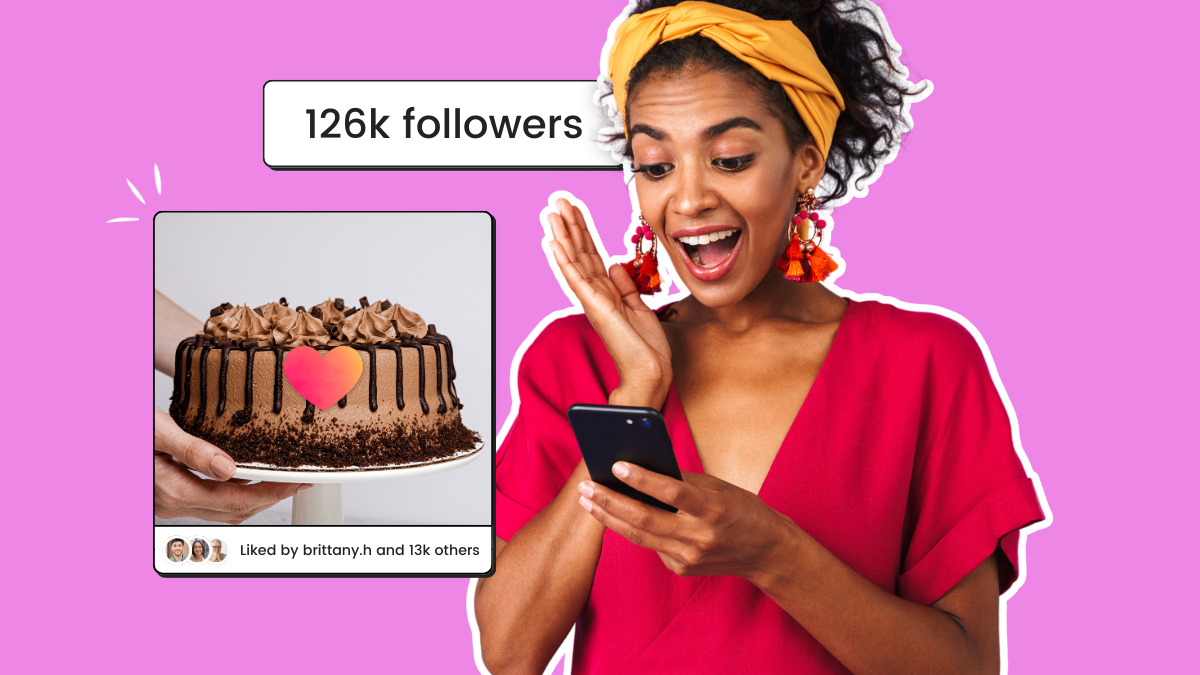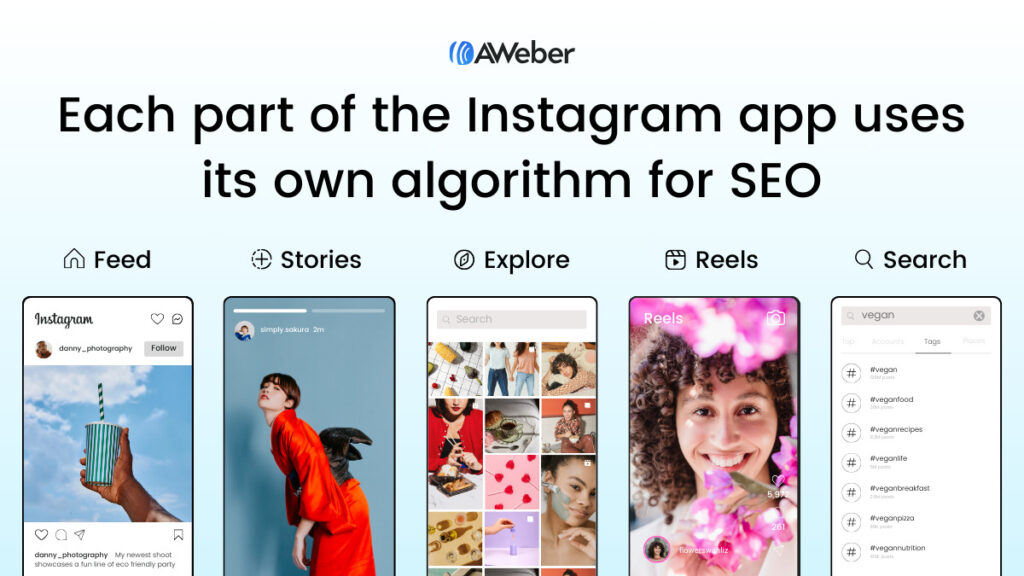
If you’ve ever wondered whether your small Instagram account can compete with giant brands on Instagram, this article is for you.
Building an audience on Instagram can feel intimidating.
Fortunately, understanding Instagram search engine optimization (SEO) can put the power of brand reach in your hands, no matter how small your business or how limited your budget.
However, if it seems tougher than ever to gain new followers and engage your audience on Instagram, you’re not imagining things. Instagram, now used by 45% of the world’s population, brings more than 2.4 billion viewers to the platform each month - along with a lot of competition for their attention.
And, if you’re still banking on compelling content and hashtags to expand your brand reach, you may have a tough time keeping up.
Today’s Instagram ranking system revolves around the platform’s native SEO and a handful of algorithm indicators.
The good news is that it’s not hard to learn or implement SEO on Instagram. We show you how to do it, plus give you some tips for gaining favor with its algorithms, in the guide below.
Instagram SEO tips, instructions, and best practices
What is Instagram SEO?
Are hashtags enough for Instagram SEO?
How to optimize your Instagram profile and content
How to optimize your Instagram profile
How to optimize Instagram image posts
How to optimize Instagram Reels
How to optimize Instagram Stories
What are Instagram ranking signals?
Instagram SEO best practices
Enhancing Instagram SEO with email marketing
What is Instagram SEO?
Instagram search engine optimization (SEO) is a way of presenting your content so that it ranks higher on Instagram Search results and in user feeds.
The platform’s algorithms are what determine how well your content ranks.
The Instagram algorithms are sets of rules and calculations used to organize and prioritize content in users’ feeds. Instagram algorithms are complex formulas, the full context of which is only known to Instagram.

“A thoughtful Instagram SEO strategy helps you organically appear in searches and stand out in the feed. It enables you to build an audience that truly cares about your brand.
But simply posting photos isn't enough. Optimizing your content for discoverability is vital. Like Google, Instagram has an algorithm that surfaces content based on relevance and engagement.”
Tristan Harris, Senior Marketing Manager, Thrive Agency
Instagram provides us with plenty of guidance on how to optimize for its search engines, so its algorithms are not a complete mystery.
Despite the complexity of it all, applying SEO to your Instagram content is quite simple.
How the Instagram algorithms and rankings work
On Instagram, there are different algorithms and processes that determine the placement of your content in its Feed, Reels, Stories, Search, and Explore tabs.

Instagram algorithms and processes constantly evolve, but you can keep up with major changes by following Instagram head Adam Mosseri on Instagram.
In the video below, Mosseri explains how content is ranked in different places on Instagram.
Are hashtags enough for Instagram SEO?
Many people still rely on Instagram hashtags to drive traffic to their pages, thinking that hashtags are synonymous with SEO.
It’s true that, prior to 2020, hashtags were the main way to optimize your content for its feeds, but things have changed. Today, hashtags play a part in optimizing your Instagram content, but you’ll also need to focus on keywords if you hope to expand your reach.

“Instagram SEO is more nuanced than using just hashtags.
It’s taken a leaf out of Google’s learning algorithm by relying on relevance of profile accounts, so you should optimize your profile bio, captions, and the images alt text.”
Gareth Boyd, Entrepreneur & Marketer, Forte Analytica
According to Instagram, hashtags are no longer an effective SEO strategy and will not help your posts rank higher on its search engine results pages.
However, many brands and agencies swear by the results they get from hashtags. There may be a couple of legitimate reasons for this:
- Hashtags help to categorize your content, which can prompt more targeted traffic to click on your posts.
- As a matter of habit, some people still type the hashtag symbol into the Instagram search engine.
- On a desktop computer, Instagram Search returns the hashtag page near the top of its search results -- and the hashtag page provides a (much) more user-friendly experience than its search results page.
Overall, hashtags still provide enough benefits to justify using them as part of your SEO strategy.
However, hashtags are not a reliable way to earn visibility on Instagram, so they should be a small part of your SEO strategy and not your main focus.
To expand your reach, awareness, and traffic on Instagram, apply simple SEO techniques (like the ones outlined below) to your profile and content.

“SEO trumps hashtags when it comes to Instagram marketing. While hashtags can help your SEO to some degree, it is not enough to boost your visibility in the Instagram SERPs by itself.
Meanwhile, a well-rounded SEO campaign that takes into account keywords, geotagging, and directly relevant hashtags will help Instagram’s search engine understand your content better so you reach meaningful audiences.”
Luciano Bellacci, Head of Marketing, Group Online Marketing Agency, Denmark
How to optimize your Instagram profile and content
By applying a few SEO basics to your profile and content, you can improve your rankings on the Search results page — especially if you’re willing to narrow your keywords to a specific niche.
Once your keywords are in place, you’ll want to consider how to gain favor with Instagram’s algorithms for higher placement across all its feeds.
How to optimize your Instagram profile
If you’re not already using an Instagram business account, you’ll need to set one up to gain full access to features such as Instagram Insights.
Next, you can optimize your Instagram profile and bio for its native search engines using the following tips:
- Customize your username: Aim for a brandable, keyword-rich username people can easily find and remember.
- Conduct keyword research: Identify relevant keywords your target audience searches for.
- Add keywords to your profile bio: Use relevant keywords within a clear description of your product or service.
- Add a high-quality profile picture: Use a brand logo or professional headshot for your profile image.
For example, vegan chef and food blogger Jenne Claiborne optimizes her Instagram profile and bio the keywords “vegan chef” and “food blogger,” and includes the keyword hashtag #veganrecipes.

How to optimize Instagram image posts
To optimize Instagram image posts for search, follow these steps:
- Include topic and brand keywords in your captions, naturally.
- Use the Alt Text feature to describe your image with relevant keywords.
- Use geo-tagging to add a location to your post (if relevant).
- Add targeted hashtags that are relevant to your post.
For example, Micron Crosby Boots uses a simple caption rich in keywords paired with a stunning image of red boots, “Who doesn’t love a classic red boot?”

How to optimize Instagram Reels
Use the following tips to optimize your Instagram Reels videos.
- Incorporate keywords into your caption.
- Add a compelling cover with a text overlay that states what your video is.
- Use a popular, trending audio track to increase your discoverability.
- Add relevant, targeted hashtags.
- Share the Reel to your feed.
For example, Hungryroot includes the keyword “seafood” several times in its Reels caption without sounding spammy. Its video opens with a text overlay that also includes the keyword.

How to optimize Instagram Stories
Optimize your Instagram Stories using the following steps.
- Use keywords in text overlays: Include relevant, targeted keywords into text overlays you add to Stories. This can help viewers who watch Stories with the sound off, plus it adds context.
- Use interactive elements such as stickers, polls, and quizzes to boost engagement, which improves your overall SEO.
- Add location tags if you have a physical location. These can greatly improve your visibility.
- Tag other accounts with mentions when appropriate, especially for collaborations.
- Pin Stories to your bio: Show off your best Stories by pinning them to your profile as Highlights. Use descriptive, keyword-rich Highlights titles when possible.
For example, Billboard often includes mention tags and other interactive elements in its Instagram Stories.


What are Instagram ranking signals?
Since Instagram’s goal is to deliver the best content to every person, its algorithms rely on indicators (ranking signals) to determine whether a person might want to see your posts, Reels, and Stories.
These indicators consider behavior such as a user’s previous interactions with your brand, as well as the level of engagement your page typically receives.
High engagement rates play a large part in boosting your visibility. Anything you can do to keep viewers engaged will improve your overall SEO and rankings.
Events, contests, and live broadcasts can go a long way toward boosting your engagement rates.
For example, Gymshark promotes both its online and in-person events, such as Gymshark 66 and Gymshark Lift, on Instagram.


Influencer partnerships and user-generated content campaigns can skyrocket your reach and engagement.

“Instagram SEO is important for Ling to reach more potential language learners and broaden our subscriber base.
We encourage our 12.2K followers to create and share content on their language learning journey to increase engagement and attract new followers.”
CEO and Co-founder, Ling App
Responding to comments and private messages establishes a relationship that the algorithm perceives as an interest indicator, which can also boost your visibility.
That’s why, once you’ve optimized for search, you’ll want to refocus your efforts on engaging your Instagram community.
Publish content people want to see, put a heavy focus on visual quality, and use Instagram Insights to discover what’s working best for your audience.
Are you stuck for ideas? Check out your competitors and industry influencers to learn what’s working well with audiences similar to yours.
Instagram SEO best practices
To optimize for search on Instagram, keep the following best practices in mind.
#1: Optimize your profile by selecting a clear username and incorporating keywords into your bio.
#2: Optimize your image posts, Reels, and Stories with strategic and relevant keyword placement in captions, overlays, and alt text.
#3: Add trending, specific, and branded hashtags to your content, but don’t rely on hashtags as your primary SEO strategy.
#4: Engage followers with interactive elements, events, contests, and prompt responses to their comments and DMs.
#5: Tag your location whenever possible (if you have a physical presence) to draw in local followers and customers.
#6: Publish high-quality photos and videos that meet Instagram size requirements.
#7: Maintain a consistent posting schedule to keep your followers engaged.
#8: Track your post performances with Instagram Insights and improve your content based on the results by posting more of the kind of content your audience responds to.
#9: Partner with influencers to give your SEO a quick boost.
By applying basic SEO techniques, such as including keywords in your profile and content, you can drive more people to your Instagram pages. For another boost in brand reach, step up your efforts to engage followers.
Bonus tip: Use your profile link to grow your email list by linking to a landing page that encourages signups.
It’s never too late to build an audience on Instagram. Once you understand how to optimize your channel and content for search engines, you can begin to expand your reach, awareness, and engagement for years to come.
Enhancing Instagram SEO with email marketing
Building an engaged audience on social media takes some effort but pays off when you develop an audience that is genuinely interested in your brand.
However, there’s no guarantee that you’ll enjoy continued visibility or access to your current followers on the platform.
Email marketing is a fantastic way to build long-term relationships and encourage more engagement on social media. It’s also an excellent way to drive more sales and ensure that you always have access to your audience.
With email marketing, you own your audience because you can download all your subscriber data for safekeeping. Unlike social media, email marketing allows you to take subscribers with you if you switch platforms.
You can use email marketing to create email nurture campaigns, send newsletters, promote your upcoming Instagram events, and much more.
Looking for a user-friendly email marketing platform that provides you with professional templates for landing pages, newsletters, signup forms, and everything you need to create professional email campaigns?
Try a free AWeber account today and discover how easy it can be to support your social media pages with email marketing!
The post Instagram SEO best practices to increase your reach appeared first on AWeber.
from AWeber https://ift.tt/PrKF4g0
via IFTTT
No comments:
Post a Comment